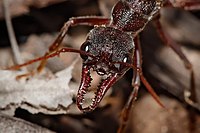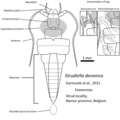Our website is made possible by displaying online advertisements to our visitors.
Please consider supporting us by disabling your ad blocker.
Portal:Insects
The Insects Portal


Insects (from Latin insectum) are hexapod invertebrates of the class Insecta. They are the largest group within the arthropod phylum. Insects have a chitinous exoskeleton, a three-part body (head, thorax and abdomen), three pairs of jointed legs, compound eyes, and a pair of antennae. Insects are the most diverse group of animals, with more than a million described species; they represent more than half of all animal species. (Full article...)
Selected article -
Beetles are insects that form the order Coleoptera (/koʊliːˈɒptərə/), in the superorder Holometabola. Their front pair of wings are hardened into wing-cases, elytra, distinguishing them from most other insects. The Coleoptera, with about 400,000 described species, is the largest of all orders, constituting almost 40% of described insects and 25% of all known animal species; new species are discovered frequently, with estimates suggesting that there are between 0.9 and 2.1 million total species. However, the number of beetle species is challenged by the number of species in dipterans (flies) and hymenopterans (wasps).
Found in almost every habitat except the sea and the polar regions, they interact with their ecosystems in several ways: beetles often feed on plants and fungi, break down animal and plant debris, and eat other invertebrates. Some species are serious agricultural pests, such as the Colorado potato beetle, while others such as Coccinellidae (ladybirds or ladybugs) eat aphids, scale insects, thrips, and other plant-sucking insects that damage crops. Some others also have unusual characteristics, such as fireflies, which use a light-emitting organ for mating and communication purposes. (Full article...)
Did you know -
- ... that the extinct rove beetle genus Ektatotricha is known from 15 beetles trapped in Cretaceous amber from Myanmar?
- ... that "Sheridan's Green Hairstreak", Callophrys sheridanii, is Wyoming's state butterfly?
- ... that one species of the extinct wasp Palaeovespa fed caterpillars to its larvae?
- ... that fighting crickets are provided with female company before the fight, stimulated with tickling during the fight, and buried in silver coffins after it?
- ... that the predatory insect Orius insidiosus is mass-reared for use in the biological control of thrips?
List articles
Related portals
General images -
Selected image -

Reduviidae (Hemiptera) is a large, cosmopolitan family of predatory insects, including the assassin bugs (genera include Melanolestes, Platymeris, Pselliopus, Rasahus, Reduvius, Rhiginia, Sinea, Triatoma, and Zelus), wheel bugs (Arilus cristatus) and thread-legged bugs (the subfamily Emesinae, including the genus Emesaya). There are about 7,000 species altogether, making it one of the largest families in the Hemiptera.
WikiProjects

Main WikiProject:
Related projects:
- WikiProject Arthropods
- WikiProject Spiders
- WikiProject Animals
- WikiProject Tree of Life
- WikiProject Biology
Daughter projects:
Tasks
 |
Here are some tasks awaiting attention:
|
Associated Wikimedia
The following Wikimedia Foundation sister projects provide more on this subject:
-
Commons
Free media repository -
Wikibooks
Free textbooks and manuals -
Wikidata
Free knowledge base -
Wikinews
Free-content news -
Wikiquote
Collection of quotations -
Wikisource
Free-content library -
Wikiversity
Free learning tools -
Wiktionary
Dictionary and thesaurus
Previous Page Next Page






















































